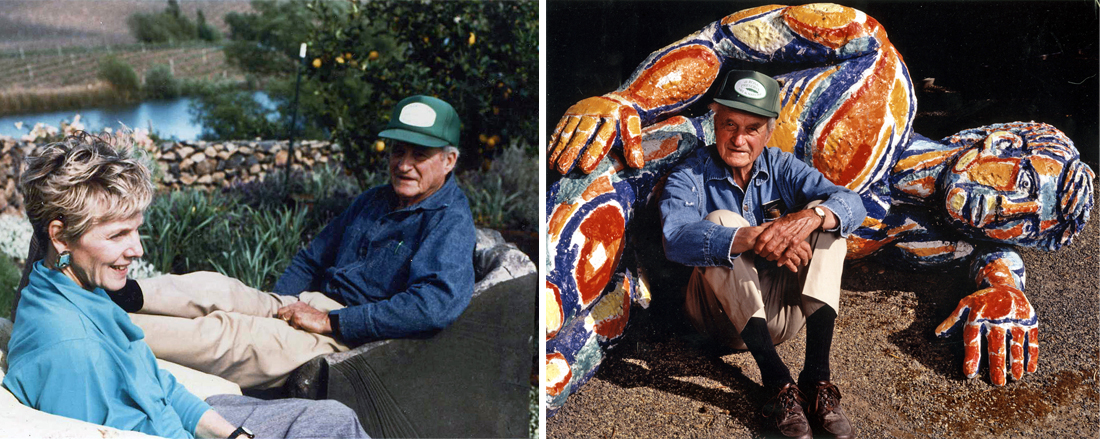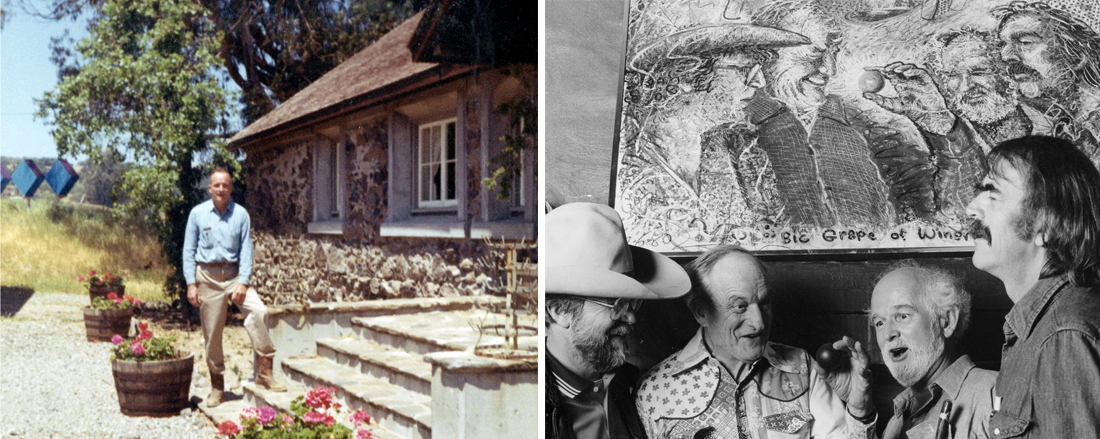 Left: Rene and Veronica di Rosa sitting in Stephen De Staebler’s Lavender Throne (1977) and Yellow Throne (1978); Right: Rene di Rosa with Viola Frey’s Reclining Nude #2 (1987). Photo: Stefan Kirkeby.
Left: Rene and Veronica di Rosa sitting in Stephen De Staebler’s Lavender Throne (1977) and Yellow Throne (1978); Right: Rene di Rosa with Viola Frey’s Reclining Nude #2 (1987). Photo: Stefan Kirkeby.
Rene and Veronica di Rosa
di Rosa Center for Contemporary Art is the vision of two devoted patrons of the arts, Rene and Veronica di Rosa. Through their generosity, the art collection, galleries, and surrounding open space were gifted to the public for the enjoyment of future generations.
Veronica di Rosa (1934–1991) was born in Canada and trained as an artist at the Emily Carr School of Art. After moving to California she became admired for her work as a watercolorist and sculptor. She married Rene di Rosa in 1976 and continued making art while becoming deeply engaged in philanthropic endeavors in Napa Valley. Veronica was an active booster of Napa Valley’s wines, music, and fine arts, and the author of several illustrated cookbooks.
Rene di Rosa (1919–2010) was born in Boston and graduated from Yale University where he was editor of the Yale Daily News. He served as a Navy lieutenant in World War II and in 1950 took a job as a reporter for the San Francisco Chronicle. While living near the burgeoning North Beach art community, he began to collect the works of emerging Bay Area artists. In 1960 he purchased land in the Carneros region of southern Napa County and planted vineyards. In pursuit of this new endeavor, he enrolled in viticulture classes at the University of California at Davis and developed what would be lifelong friendships with many of the artists who have become the backbone of the di Rosa collection; artists such as Robert Arneson, Roy De Forest, Manuel Neri, and William T. Wiley were all art professors at Davis in the mid-1960s. In the years that followed, Rene became an avid collector and arts activist, serving on the Board of Trustees of the San Francisco Museum of Modern Art, The San Francisco Art Institute, and New York’s Whitney Museum National Committee.
 Left: Rene di Rosa in front of the Residence. Right: Robert Hudson, Rene di Rosa, Robert Arneson, and William T. Wiley in front of Robert Arneson’s Big Grape of Winery Lake (1980).
Left: Rene di Rosa in front of the Residence. Right: Robert Hudson, Rene di Rosa, Robert Arneson, and William T. Wiley in front of Robert Arneson’s Big Grape of Winery Lake (1980).
The Site
di Rosa Center for Contemporary Art occupies 217 acres of the original 465 acres of land purchased by Rene di Rosa in 1960. The property was originally part of the huge Rancho Huichica land grant. The current property, carved out of that grant, was purchased by William Winter in 1855. He planted about 70 acres of grapes and olive trees. In 1884 the property was purchased by two Frenchmen, Michael Debret and Pierre Priet, who named it the Debret Vineyard and built a stone winery in 1886. Phylloxera (root louse) at the end of the 19th century ended those vineyards and the stone winery was eventually used for other things including growing mushrooms, making moonshine, a granary, and ultimately a hay barn. When Rene bought the property, the land and stone winery had over the years fallen into disuse and disrepair.
Rene di Rosa’s purchase of the acreage turned the land from dairy cattle and reestablished grapes. Beginning with the purchase in 1960, he converted the stone winery structure into a house, adding interior rooms, doors, windows, and a bell tower. The property’s lake began as a pond dug by WPA workers in the 1930s for irrigation in the surrounding area. Rene built a dam and extended “the pond” into a 35-acre lake, naming it Winery Lake.
In 1963 Winery Lake Vineyards was established. Vines eventually covered some 250 acres and the quality fruit was sought by over 50 wineries. Rene sold these famed vineyards to Seagram in 1986, using the profits to establish the Rene and Veronica di Rosa Foundation to build an “art park” for the greater public. As a manifestation of that vision, di Rosa opened to the public in 1997 and became a separate nonprofit 501(c)3 organization in 2000. Originally known as the di Rosa Preserve: Art & Nature, the organization changed its name to the di Rosa Center for Contemporary Art in 2017. The property encompasses multiple galleries and a sculpture meadow and is protected in perpetuity under the Napa County Land Trust.
